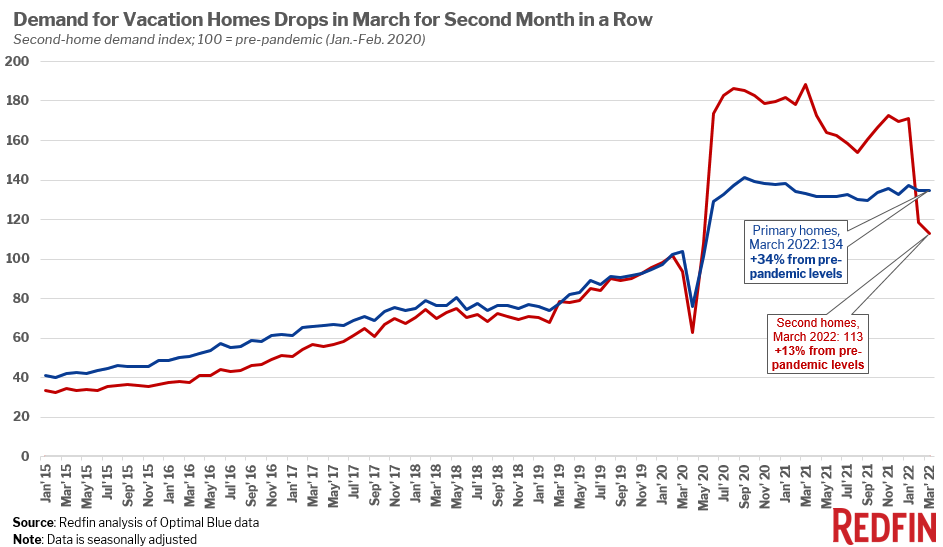After last year’s frenzy for vacation homes, buyers are now backing off amid rising mortgage rates and an increase in loan fees for second homes.
Demand for vacation homes dropped sharply for the second month in a row in March, with mortgage-rate locks for second homes at their lowest level since May 2020.
Demand for vacation homes was still up 13% from pre-pandemic levels, but it’s declining after a pandemic-fueled second-home boom last year. Still, we expect demand for second homes to remain above pre-pandemic levels in the future, as remote work is here to stay for many Americans.
The slowdown in demand for vacation homes joins other early signals that the historically fast rise in mortgage rates and record-high home prices are pricing out some buyers.
“The pandemic-driven surge in sales of vacation homes is coming to an end as mortgage rates rise at their fastest pace in history, causing some second-home buyers to back off,” said Redfin Deputy Chief Economist Taylor Marr. “When rates and prices shoot up so much that a vacation home starts to look more like a burden than a good investment and a fun place to bring your family on the weekends, a lot of prospective buyers have second thoughts. The new second-home loan fees that kicked in on April 1 were also a deterrent. Plus, some buyers’ down payments–and their nerves–probably took a hit when the stock market dipped over the last few months.”
Growth in demand for primary residences outpaced that of second homes for the second month in a row, with mortgage-rate locks for primary homes up 34% from pre-pandemic levels. Demand for primary residences has remained at roughly the same level since June 2020.

Interest in vacation homes skyrocketed in mid-2020 as many affluent Americans started working remotely and mortgage rates dropped to record lows, with mortgage-rate locks for second homes reaching a peak of 88% above pre-pandemic levels in March 2021. Demand declined sharply over the last two months as mortgage rates shot up at their fastest pace in history, reaching 4.67% by the end of March, and some workers started returning to the office.
Another deterrent to demand was the impending rise in loan fees for second-home loans, which increased by about 1% to 4% starting on April 1. The change adds about $13,500 to the cost of purchasing a $400,000 home for the typical vacation-home buyer and will continue to cool interest in vacation homes in the coming months.
The data in this report is from a Redfin analysis of mortgage-rate lock data from real estate analytics firm Optimal Blue. Redfin created a seasonally adjusted index of Optimal Blue’s data to adjust for typical seasonal patterns and allow for simple comparisons of second-home demand during and before the pandemic. We define “pre-pandemic” as January and February 2020 and set the index for that period to 100. Any data point above 100 represents second-home demand that’s above pre-pandemic levels and any data point below 100 represents demand below pre-pandemic levels. This data is subject to revision.
A mortgage-rate lock is an agreement between a homebuyer and a lender that allows the homebuyer to lock in an interest rate on a mortgage for a certain period of time, offering protection against future interest-rate hikes. Homebuyers must specify whether they are applying to secure a mortgage rate for a primary home, a second home or an investment property. Roughly 80% of mortgage-rate locks result in actual home purchases.


